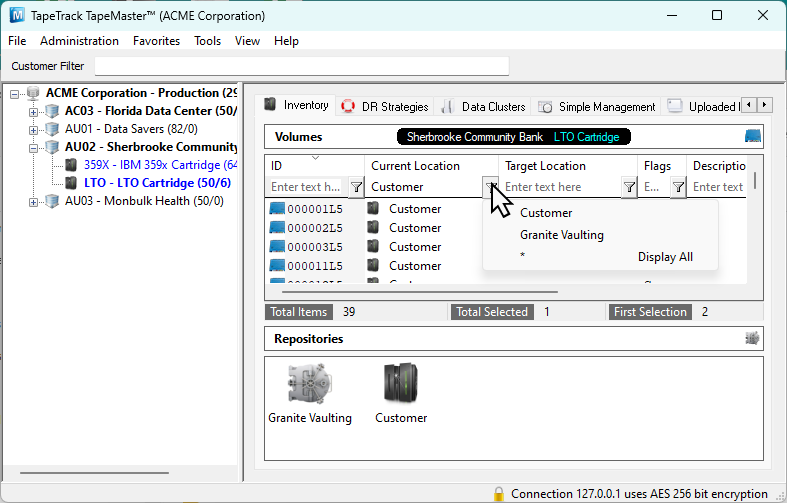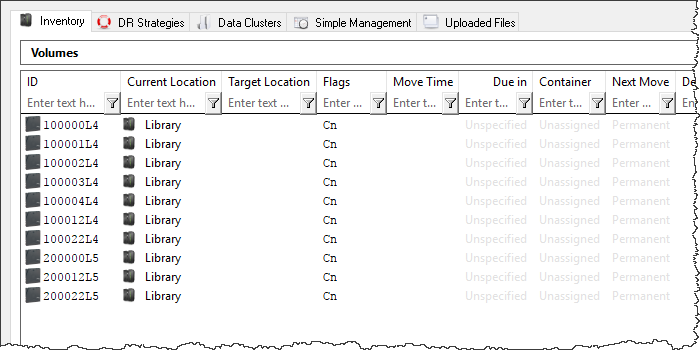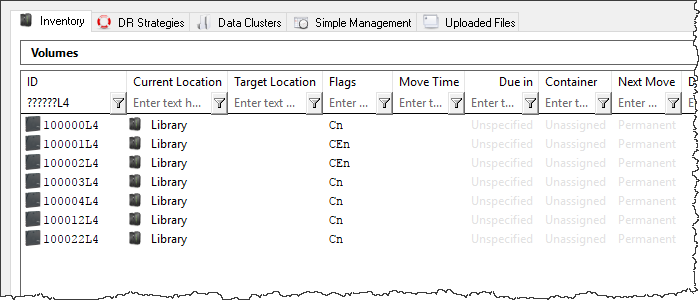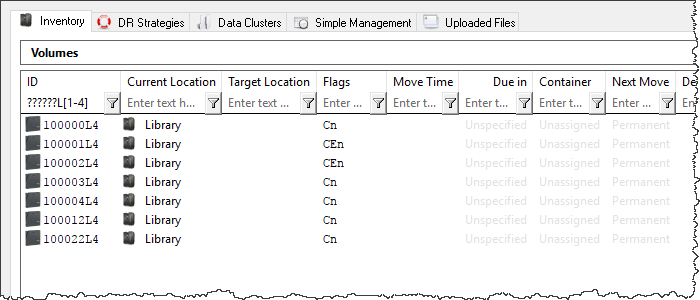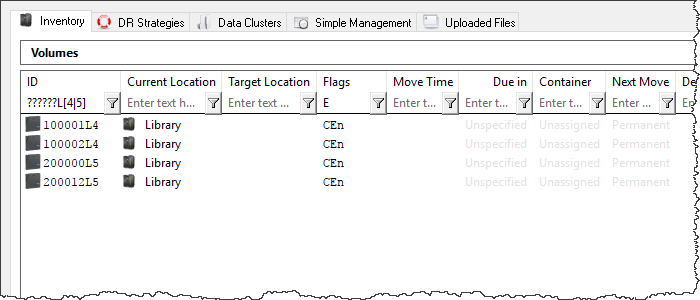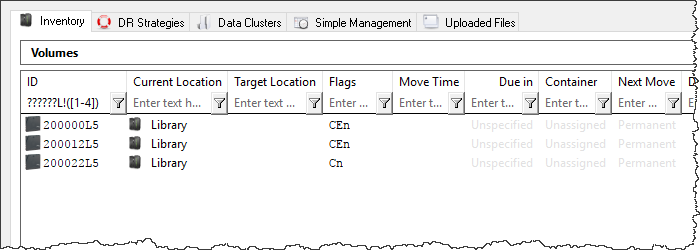Table of Contents
Pattern Matching And Filter Strings
TapeTrack has powerful pattern matching functionality that can be utilized globally in TapeMaster.
TapeMaster Quick Filters
TapeMaster fields can be filtered by Repository, Flags, Next Move and/or Container by using the funnel buttons on the right of the filter fields.
To use quick filters just click on the required column funnel and select the filter value.
String Pattern Matching
To illustrate the effects of where and how the asterisk wildcard affects search results all examples will be performed against the following Volume values.
100000L4, 100001L4, 100002L4, 100003L4, 100004L4, 100012L4, 100022L4, 200000L5, 200012L5, 200022L5
Asterisk (*)
The Asterisk is used as a wildcard to allow String matching in multiple positions and variable String lengths.
- An Asterisk before a set of characters will show all items that end with those characters.
Using the filter*L4in the Volume-ID field will show all Volume-ID's ending in L4.
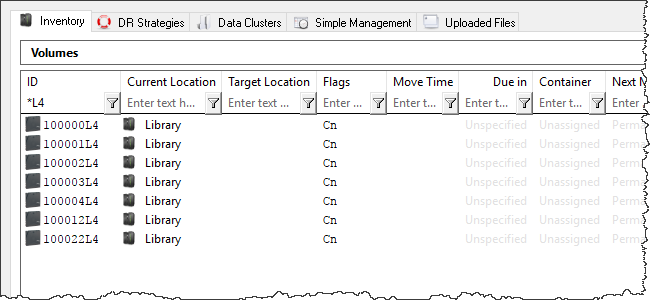
- An Asterisk after a set of characters will show all items that begin with those characters.
Using the filter20*in the Volume-ID field will display all Volume-ID's starting with 20.

- If used on its own, the Asterisk will match everything and, as such, will have no effect on Volumes displayed.
- Using two Asterisks, one on either side of a character or set of characters will show all items containing that character or set of characters at any character position.
Using the filter*02*in the Volume-ID field will display all Volume-ID's that have 02 anywhere within the ID.

- The Asterisk does not need to be used when entering a full Object-ID or when searching for Flags in the Volume List.

Question Mark (?)
The Question Mark is used to indicate that any character can exist in a specific character position.
Using the filter ??????L4 in the Volume-ID field will display all eight character Volume-ID's ending in L4.
Square Brackets ([ ])
Square Brackets can be used to provide parameters for a specific character position that are longer than one character. There are four different configurations:
Multiple Characters
When multiple characters are put in a Square Bracket, any of the characters listed will be displayed at the specified character position.
Using the filter, in the Volume-ID field, [12]?????L[45] will display all eight character Volume-ID's that start in either 1 or 2 and end in either L4 or L5.
Range Of Characters
Using the filter, in the Volume-ID field, [12]?????L[4-7] will display all eight character Volume-ID's that start in either 1 or 2 and end in either L4, L5, L6 or L7.
Vertical Bar (|)
When two or more characters are placed between Square Brackets and separated by Vertical Bars, the Vertical Bar will act as the word “OR” displaying any of the characters.
Using the filter, in the Volume-ID field, ??????L[4|5] will display all eight character Volume-ID's that end in either L4 OR L5.
Hyphen (-)
When two characters are placed between Square Brackets and separated by a Hyphen, any character alphanumerically between the two characters inclusive will display.
Using the filter, in the Volume-ID field, ??????L[1-4] will display all eight character Volume-ID's that end in L1, L2, L3 OR L4.
Exclamation Point (!)
When the Exclamation Point is placed immediately following the left Square Bracket in a set of Square Brackets, any character except for the characters listed after the Exclamation Point will display. This functionality also works with Multiple Characters, Vertical Bars, and Hyphens.
Using the filter, in the Volume-ID field, ??????L!([1-4]) will display all eight character Volume-ID's that start end in anything other than 1, 2, 3 or 4.
Date Pattern Matching
TapeTrack Date Format
TapeTrack allows you to represent dates both as literal date values and date calculations.
Syntax
| Syntax | Description |
|---|---|
| YYYY-MM-DD | ISO Date Format |
| * | Today |
| W | This Week |
| P | The oldest Date |
| F | The most Future Date |
| *±x | Today ± number of days (x). |
| M | The first day of this month |
| m | The last day of this month. |
| Y | The first day of the year. |
| y | The last day of the year. |
| M±x | The first day of the month ± number of months (x). |
| M±x±y | The first day of the month ± number of months (x), ± number of days (y). |
| Y±x | The first day of the year ± x number of years |
| Y±x±y | The first day of the year ± number of years (x) ± number of months (y). |
| Y±x±y±z | The first day of the year ± number of years (x) ± number of months (y) ± number of days (z). |
Examples
| Date Syntax | Description |
|---|---|
| *-10 | Today - 10 days |
| W-10 | 10 Weeks ago |
| W+2 | 2 Weeks in the future |
| M | The first day of this month |
| M-1 | The first day of last month |
| Y | The beginning of this year |
| y-1 | The last day of last year |
| Y-1+3-1 | The last day of February last year |
| P | The oldest date |
| P+50 | The oldest date plus 50 days |
| F | The most future date |
| Date Range Syntax | Description |
|---|---|
| *-10:* | 10 days ago until today |
| W-2:* | Two weeks ago until today |
| M-4:W+2 | First day of four months ago until two weeks from today |
Pattern Matching
| Syntax | Description |
|---|---|
| ???? | 4 Character long |
| ????* | 4 or more long |
| !(?*) |

